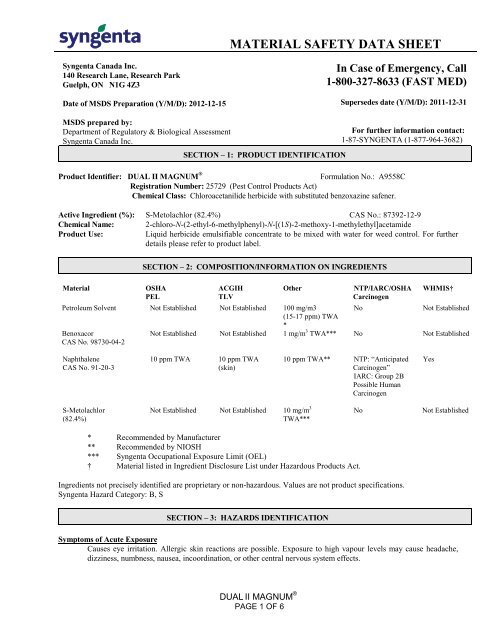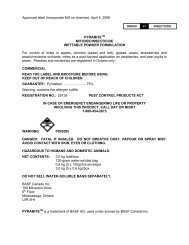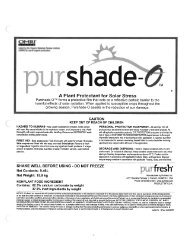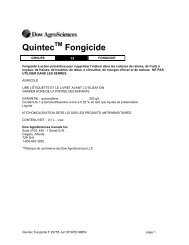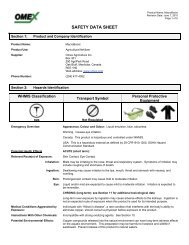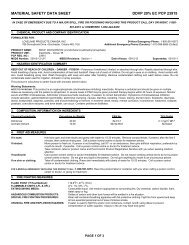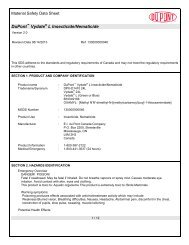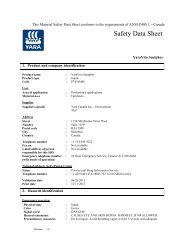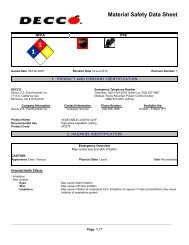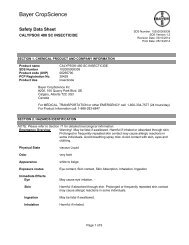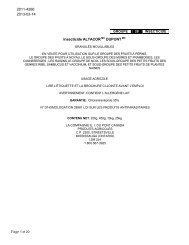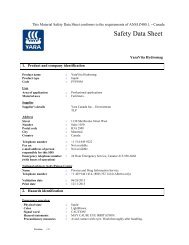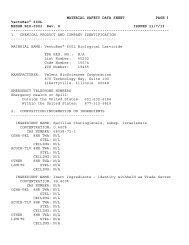Dual II Magnum msds english.pdf - Bartlett.ca
Dual II Magnum msds english.pdf - Bartlett.ca
Dual II Magnum msds english.pdf - Bartlett.ca
You also want an ePaper? Increase the reach of your titles
YUMPU automatically turns print PDFs into web optimized ePapers that Google loves.
MATERIAL SAFETY DATA SHEETSyngenta Canada Inc.140 Research Lane, Research ParkGuelph, ON N1G 4Z3Date of MSDS Preparation (Y/M/D): 2012-12-15In Case of Emergency, Call1-800-327-8633 (FAST MED)Supersedes date (Y/M/D): 2011-12-31MSDS prepared by:Department of Regulatory & Biologi<strong>ca</strong>l AssessmentSyngenta Canada Inc.SECTION – 1: PRODUCT IDENTIFICATIONFor further information contact:1-87-SYNGENTA (1-877-964-3682)Product Identifier: DUAL <strong>II</strong> MAGNUM ®Formulation No.: A9558CRegistration Number: 25729 (Pest Control Products Act)Chemi<strong>ca</strong>l Class: Chloroacetanilide herbicide with substituted benzoxazine safener.Active Ingredient (%): S-Metolachlor (82.4%) CAS No.: 87392-12-9Chemi<strong>ca</strong>l Name: 2-chloro-N-(2-ethyl-6-methylphenyl)-N-[(1S)-2-methoxy-1-methylethyl]acetamideProduct Use:Liquid herbicide emulsifiable concentrate to be mixed with water for weed control. For furtherdetails please refer to product label.SECTION – 2: COMPOSITION/INFORMATION ON INGREDIENTSMaterialOSHAPELACGIHTLVOtherPetroleum Solvent Not Established Not Established 100 mg/m3(15-17 ppm) TWA*BenoxacorCAS No. 98730-04-2NTP/IARC/OSHACarcinogenNoWHMIS†Not EstablishedNot Established Not Established 1 mg/m 3 TWA*** No Not EstablishedNaphthaleneCAS No. 91-20-310 ppm TWA 10 ppm TWA(skin)10 ppm TWA** NTP: “AnticipatedCarcinogen”IARC: Group 2BPossible HumanCarcinogenYesS-Metolachlor(82.4%)Not Established Not Established 10 mg/m 3TWA***NoNot Established* Recommended by Manufacturer** Recommended by NIOSH*** Syngenta Occupational Exposure Limit (OEL)† Material listed in Ingredient Disclosure List under Hazardous Products Act.Ingredients not precisely identified are proprietary or non-hazardous. Values are not product specifi<strong>ca</strong>tions.Syngenta Hazard Category: B, SSECTION – 3: HAZARDS IDENTIFICATIONSymptoms of Acute ExposureCauses eye irritation. Allergic skin reactions are possible. Exposure to high vapour levels may <strong>ca</strong>use headache,dizziness, numbness, nausea, incoordination, or other central nervous system effects.DUAL <strong>II</strong> MAGNUM ®PAGE 1 OF 6
Hazardous Decomposition ProductsCan decompose at high temperatures forming toxic gases.Physi<strong>ca</strong>l PropertiesAppearance: Dark brown Liquid.Odour: Petroleum-like odour.Unusual Fire, Explosion and Reactivity HazardsDuring a fire, irritating and possibly toxic gases may be generated by thermal decomposition or combustion.Potential Health EffectsRelevant routes of exposure: Skin, eyes, mouth, lungs.SECTION – 4: FIRST AID MEASURESIF POISONING IS SUSPECTED, immediately contact the poison information centre, doctor or nearest hospital. Havethe product container, label or Material Safety Data Sheet with you when <strong>ca</strong>lling Syngenta, a poison control center or,doctor, or going for treatment. Tell the person contacted the complete product name, and the type and amount of exposure.Describe any symptoms and follow the advice given. Call the Syngenta Emergency Line [1-800-327-8633 (1-800-FASTMED)], for further information.EYE CONTACT:SKIN CONTACT:INHALATION:INGESTION:Flush eyes with clean water, holding eyelids apart for a minimum of 15 - 20 minutes. Removecontact lenses, if present, after 5 minutes, then continue rinsing eye. Call Syngenta, a poisoncontrol center or doctor for treatment advice. Obtain medi<strong>ca</strong>l attention immediately if irritationpersists.Immediately remove contaminated clothing and wash skin, hair and fingernails thoroughly withsoap and water. Flush skin with running water for a minimum of 15-20 minutes. Obtain medi<strong>ca</strong>lattention if irritation occurs.Move victim to fresh air. If not breathing, <strong>ca</strong>ll 911 or an ambulance, then give artificialrespiration, preferably mouth-to-mouth, if possible. Call Syngenta, a poison control centre ordoctor for treatment advice.If swallowed, immediately contact Syngenta, a poison control centre, doctor or nearest hospital fortreatment advice. Do not induce vomiting unless directed by a physician or a poison controlcenter. Do not give any liquid to the person. Do not give anything by mouth to an unconsciousperson.NOTES TO PHYSICIAN:There is no specific antidote if this product is ingested. Treat symptomati<strong>ca</strong>lly. Contains petroleum distillate - vomiting may<strong>ca</strong>use aspiration pneumonia. Temporary allergic skin reactions may respond to treatment with oral antihistamines or steroidcreams and/or systemic steroids.MEDICAL CONDITIONS KNOWN TO BE AGGRAVATED:None known.SECTION – 5: FIRE FIGHTING MEASURESFlash point and method: >93.3 ºC (Setaflash).Upper and lower flammable (explosive) limits in air: Not available.Auto-ignition temperature: Not available.Flammability: Not flammable.Hazardous combustion products: Thermal decomposition products may include <strong>ca</strong>rbon monoxide, <strong>ca</strong>rbon dioxide, hydrogencyanide, acetonitrile, oxides of sulfur, hydrogen sulphide, oxides of nitrogen and phosphorous.Conditions under which flammability could occur: High temperatures, open flames. Product is not flammable. Keep fireexposed containers cool by spraying with water.DUAL <strong>II</strong> MAGNUM ®PAGE 2 OF 6
Extinguishing media: Use foam, <strong>ca</strong>rbon dioxide, dry powder or halon extinguishant. Wear full protective clothing andself-contained breathing apparatus. Evacuate nonessential personnel from the area to prevent human exposure to fire,smoke, fumes or products of combustion. Prevent use of contaminated buildings, area, and equipment until decontaminated.Water runoff <strong>ca</strong>n <strong>ca</strong>use environmental damage. Contain run-off water with, for example, temporary earth barriers.Sensitivity to explosion by mechani<strong>ca</strong>l impact: No.Sensitivity to explosion by static discharge: No.SECTION – 6: ACCIDENTAL RELEASE MEASURESPersonal Pre<strong>ca</strong>utions: Make sure all personnel involved in the spill cleanup follow good industrial hygiene practices. Asmall spill <strong>ca</strong>n be handled routinely. Use adequate ventilation and wear equipment and clothing as described in Section 8and/or the product label.Procedures for dealing with release or spill: Control the spill at its source. Contain the spill to prevent from spreading orcontaminating soil or from entering sewage and drainage systems or any body of water. Clean up spills immediately, observingpre<strong>ca</strong>utions outlined in Sections 7 and 8. Scoop or sweep up material, keeping dust to a minimum, and place into a disposablecontainer. Wash area with detergent and water. Pick up wash liquid with additional absorbent and place into compatibledisposal container. On soils, small amounts will naturally decompose. For large amounts, skim off the upper contaminatedlayer and collect for disposal. Once all material is cleaned up and placed in a disposal container, seal container and arrange fordisposal. Spillages or uncontrolled discharges into watercourses must be reported to the appropriate regulatory authority.SECTION – 7: HANDLING AND STORAGEHandling practices: KEEP OUT OF REACH OF CHILDREN. Prevent eating, drinking, tobacco use, and cosmeti<strong>ca</strong>ppli<strong>ca</strong>tion in areas where there is a potential for exposure to the material. After work, rinse gloves and remove protectiveequipment, and wash hands thoroughly with soap and water after handling, and before eating, tobacco use, drinking,applying cosmetics or using the toilet. Wash contaminated clothing before re-use and separate from household laundry.Keep containers closed when not in use. Protect product, wash or rinse water, and contaminated materials fromuncontrolled release into the environment, or from access by animals, birds or unauthorized people.Appropriate storage practices/requirements: Store in original container only in a well-ventilated, cool, dry, secure area.Protect from heat, sparks and flame. Do not expose sealed containers to temperatures above 40 °C. Keep separate fromother products to prevent cross contamination. Rotate stock. Clean up spilled material immediately.National Fire Code classifi<strong>ca</strong>tion: Not appli<strong>ca</strong>ble.SECTION – 8: EXPOSURE CONTROLS/PERSONAL PROTECTIONAppli<strong>ca</strong>ble control measures, including engineering controls: This product is intended for use outdoors where engineeringcontrols are not necessary. If necessary, ensure work areas have ventilation, containment, and procedures sufficient to maintainairborne levels below the TLV. Warehouses, production area, parking lots and waste holding facilities must have adequatecontainment to prevent environmental contamination. Provide separate shower and eating facilities.THE FOLLOWING RECOMMENDATIONS FOR EXPOSURE CONTROLS/PERSONAL PROTECTION ARE INTENDEDFOR THE MANUFACTURE, FORMULATION, PACKAGING AND USE OF THIS PRODUCT.CONSULT THE PRODUCT LABEL FOR COMMERCIAL APPLICATIONS AND/OR ON-FARM APPLICATIONS.Personal protective equipment for each exposure route:General: Avoid breathing dust, vapours or aerosols. Avoid contact with eye, skin and clothing. Wash thoroughly afterhandling and before eating, drinking, applying cosmetics or handling tobacco.INGESTION: Do not eat, drink, handle tobacco, or apply cosmetics in areas where there is a potential for exposure tothis material. Always wash thoroughly after handling.EYES: Where eye contact is likely, use chemi<strong>ca</strong>l splash goggles. Facilities storing or utilizing this materialshould be equipped with an eyewash facility and a safety shower.SKIN: Where contact is likely, wear chemi<strong>ca</strong>l-resistant (such as nitrile or butyl) gloves, coveralls, socks andchemi<strong>ca</strong>l-resistant footwear. For overhead exposure, wear chemi<strong>ca</strong>l-resistant headgear.DUAL <strong>II</strong> MAGNUM ®PAGE 3 OF 6
INHALATION: A respirator is not normally required when handling this substance. Use process enclosures, lo<strong>ca</strong>l exhaustventilation, or other engineering controls to keep airborne levels below exposure limits. A NIOSHcertifiedcombination air-purifying respirator with an N, P or R 95 or HE class filter and an organic vapor<strong>ca</strong>rtridge may be permissible under certain circumstances where airborne concentrations are expected toexceed exposure limits. Protection provided by air-purifying respirators is limited. Use a pressure demandatmosphere-supplying respirator if there is any potential for uncontrolled release, exposure levels are notknown, or under any other circumstances where air-purifying respirators may not provide adequateprotection.SECTION – 9: PHYSICAL AND CHEMICAL PROPERTIESAppearance: Dark brown Liquid.Formulation Type: Emulsifiable concentrate.Odour: Petroleum-like odour.pH: 7.2 (1% aqueous solution @ 25 ºC).Vapour pressure and reference temperature: 2.8 x 10 -5 mmHg @ 25 °C (s-Metolachlor Techni<strong>ca</strong>l).Vapour density: Not available.Boiling point: Not available.Melting point: Not available.Freezing point: - 20 ºCSpecific gravity or density: 1.11 g/cm 3 @ 20 ºC.Evaporation Rate: Not available.Water/oil partition coefficient: Not available.Odour threshold: Not available.Viscosity: 119 mPas (or cps) @ 20 ºC.Solubility in Water: 0.48 g/L @ 25 ºC (s-Metolachlor Techni<strong>ca</strong>l).SECTION – 10: STABILITY AND REACTIVITYChemi<strong>ca</strong>l stability: Stable under normal use and storage conditions.Conditions to avoid: Excessive heat or cold.Incompatibility with other materials: Certain plastics, particularly PVC, and rubber dissolve or soften in contact with S-metolachlor. Avoid strong oxidizing agents such as hydrogen peroxide, bromine, chromic acid. S-metolachlor is hydrolysed bystrong alkalis and strong mineral acids.Hazardous decomposition products: Can decompose at high temperatures forming toxic gases. Thermal decompositionproducts may include <strong>ca</strong>rbon monoxide, <strong>ca</strong>rbon dioxide, hydrogen cyanide, acetonitrile, oxides of sulfur, hydrogensulphide, oxides of nitrogen and phosphorous.Hazardous polymerization: Will not occur.SECTION – 11: TOXICOLOGICAL INFORMATIONAcute toxicity/Irritation Studies (Finished Product):Ingestion:Low Acute ToxicityOral (LD50 Rat):2,149 mg/kg body weightDermal:Inhalation:Eye Contact:Skin Contact:Skin Sensitization:Low Acute ToxicityDermal (LD50 Rabbit):Low Acute ToxicityInhalation (LC50 Rat):Moderately Irritating (Rabbit)Slightly Irritating (Rabbit)Sensitizer (Guinea Pig)> 2,020 mg/kg body weight> 3.8 mg/L air - 4 hoursDUAL <strong>II</strong> MAGNUM ®PAGE 4 OF 6
Reproductive/Developmental Effectss-Metolachlor Techni<strong>ca</strong>l: None observed.Chronic/Subchronic Toxicity Studiess-Metolachlor Techni<strong>ca</strong>l: None observed.Carcinogenicitys-Metolachlor Techni<strong>ca</strong>l:Benign liver tumours at high dose levels (female rats).Other Toxicity Information:None.Toxicity of Other ComponentsTest results reported in Section 11 for the finished product take into account any acute hazards related to theexcipient ingredients in the formulation.Petroleum Solvent;Inhalation of vapors at high concentrations <strong>ca</strong>n <strong>ca</strong>use central nervous system effects (dizziness,headache), irritation to eyes or respiratory tract.Benoxacor:No additional information.Naphthalene:Chronic overexposure to naphthalene <strong>ca</strong>n affect the liver, kidney, respiratory tract and blood.Carcinogen Status:NTP: Anticipated CarcinogenIARC: Group 2B Possible Human CarcinogenOther materials that show synergistic toxic effects together with the product: None known.Target OrgansActive Ingredients-Metolachlor Techni<strong>ca</strong>l:Inert IngredientsPetroleum Solvent:Benoxacor:Naphthalene:Liver.Respiratory tract, stomach, liver, thyroid, urinary bladder, CNS, skinNot Appli<strong>ca</strong>ble.Liver, blood, kidneys and respiratory tract.SECTION – 12: ECOLOGICAL INFORMATIONSummary of EffectsThe active ingredient, s-metolachlor, is practi<strong>ca</strong>lly nontoxic to birds but is very toxic to aquatic organisms.Eco-Acute Toxicitys-Metolachlor Techni<strong>ca</strong>l:Green Algae 5-day EC 50Invertebrate (Water Flea) 48-Hour LC 50Fish (Rainbow Trout) 96-hour LC 50 /EC 50Birds (Bobwhite Quail) LD 500.008 ppm26 ppm11.9 ppm> 2,510 mg/kgEnvironmental FateThe active ingredient, S-metolachlor, has a low bioaccumulation potential, slight to moderate mobility in soil, andlow to moderate persistence in soil and water.DUAL <strong>II</strong> MAGNUM ®PAGE 5 OF 6
SECTION – 13: DISPOSAL CONSIDERATIONSWaste disposal information: Do not reuse empty containers unless they are specifi<strong>ca</strong>lly designed to be re-filled. Emptycontainer retains product residue. Dispose of empty containers in accordance with lo<strong>ca</strong>l regulations. Consult provincialenvironment ministry for advice on waste disposal. Industrial/commercial waste may be handled at licensed facilities only.Waste shipments must be securely packaged and properly labelled. Only licensed <strong>ca</strong>rriers may be used, and proper documentsmust accompany the shipment.SECTION – 14: TRANSPORT INFORMATIONShipping information such as shipping classifi<strong>ca</strong>tion:TRANSPORTATION OF DANGEROUS GOODS CLASSIFICATION - ROAD/RAILNot Regulated.SECTION – 15: REGULATORY INFORMATIONWHMIS classifi<strong>ca</strong>tion for product: ExemptA statement that the MSDS has been prepared to meet WHMIS requirements, except for use of the 16 headings.This MSDS has been prepared in accordance with WHMIS requirements, but the data are presented under 16 headings.Other regulations; restrictions and prohibitionsPest Control Products (PCP) Act Registration No.: 25729SECTION – 16: OTHER INFORMATIONThe information contained herein is offered only as a guide to the handling of this specific material and has been preparedin good faith by techni<strong>ca</strong>lly knowledgeable personnel. It is not intended to be all-inclusive and the manner and conditionsof use and handling may involve other and additional considerations. No warranty of any kind is given or implied andSyngenta will not be liable for any damages, losses, injuries or consequential damages which may result from the use of orreliance on any information contained herein. This Material Safety Data Sheet is valid for three years. This product is underthe jurisdiction of the Pest Control Products Act and is exempt from the requirements for a WHMIS compliant MSDS.Hazardous properties of all ingredients have been considered in the preparation of this MSDS. Read the entire MSDS forthe complete hazard evaluation of this product.Prepared by: Syngenta Canada Inc.1-87-SYNGENTA (1-877-964-3682)Syngenta Canada Inc. believes that the information and recommendations contained herein (including data and statements)are accurate as of the date thereof. NO WARRANTY OF FITNESS FOR ANY PARTICULAR PURPOSE, WARRANTYOF MERCHANTABILITY, OR ANY OTHER WARRANTY, EXPRESS OR IMPLIED, IS MADE CONCERNING THEINFORMATION PROVIDED HEREIN. The information provided herein relates to the specific product designated andmay not be valid where such product is used in combination with any other materials or in any process. Further, since theconditions and methods of use of the product and of the information referred to herein are beyond the control of SyngentaCanada Inc., Syngenta Canada Inc. expressly disclaims any and all liability as to any results obtained or arising from anyuse of the product or reliance on such information.DUAL <strong>II</strong> MAGNUM ® is a trademark of a Syngenta Group Company.DUAL <strong>II</strong> MAGNUM ®PAGE 6 OF 6


